Volcanic Tremor of Mt. Etna (Italy) Recorded by NEMO-SN1 Seafloor Observatory: A New Perspective on Volcanic Eruptions Monitoring
Abstract
1. Introduction
2. The NEMO-SN1 Seafloor Observatory
3. The 2002-2003 Mt. Etna Eruption
4. Background Seismic Signals from NEMO-SN1
5. Time, Spectral, and Polarization Analyses
6. Comparison between Volcanic Tremor and Oceanographic Noise
7. Discussion and Conclusions
Author Contributions
Funding
Acknowledgments
Conflicts of Interest
References
- Favali, P.; Person, R.; Barnes, C.R.; Kaneda, Y.; Delaney, J.R.; Hsu, S.-K. Seafloor Observatory Science. In Proceedings of the OceanObs’09: Sustained Ocean Observations and Information for Society conference 2.2010, Venice, Italy, 21–25 September 2009; Hall, J., Harrison, D.E., Stammer, D., Eds.; ESA Publication: Venice, Italy, 2010. WPP-306. ISSN 1609-042X. [Google Scholar]
- Favali, P.; Beranzoli, L.; De Santis, A. (Eds.) Seafloor Observatories: A New Vision of the Earth from the Abyss. Springer-Praxis Books in Geophysical Sciences; Springer: Berlin/Heidelberg, Germany, 2015; 676p, ISBN 978-3-642-11373-4. e-ISBN 978-3-642-11374-1. [Google Scholar] [CrossRef]
- Butler, R.; Chave, A.D.; Duennebier, F.K.; Yoerger, D.R.; Petitt, R.; Harris, D.; Wooding, F.B.; Bowen, A.D.; Bailey, J.; Jolly, J.; et al. Hawaii-2 Observatory pioneers opportunities for remote instrumentation in ocean studies. Eos Trans. AGU 2000, 81, 161–163. [Google Scholar] [CrossRef]
- Caplan-Auerbach, J.; Duennebier, F.K. Seismic and acoustic signals detected at Lo’ihi Seamount by the Hawaii Undersea Geo-Observatory. Geochem. Geophys. Geosys. 2001, 2. [Google Scholar] [CrossRef]
- ONC-Ocean Networks Canada. Available online: www.oceannetworks.ca (accessed on 20 December 2018).
- Fox, C.G.; Dziak, R.P.; Matsumoto, H.; Schreiner, A.E. Potential for monitoring low level seismicity on the Juan de Fuca Ridge using military hydrophone arrays. Mar. Technol. Soc. J. 1994, 27, 22–30. [Google Scholar]
- Dziak, R.P.; Hammond, S.R.; Fox, C.G. A 20-year hydroacoustic time series of seismic and volcanic events in the Northeast Pacific Ocean. Oceanography 2011, 24, 280–293. [Google Scholar] [CrossRef]
- OOI-Ocean Observatories Initiative. Available online: https://oceanobservatories.org/ (accessed on 18 September 2018).
- Tolstoy, M.; Wilcock, W.S.D.; Tan, Y.J.; Waldhauser, F. A tale of two eruptions: How data from Axial Seamount led to a discovery on the East Pacific Rise. Oceanography 2018, 31, 124–125. [Google Scholar] [CrossRef]
- Wilcock, W.S.D.; Dziak, R.P.; Tolstoy, M.; Chadwick, W.W., Jr.; Nooner, S.L.; Bohnenstiehl, D.R.; Caplan-Auerbach, J.; Waldhauser, F.; Arnulf, A.F.; Baillard, C.; et al. The recent volcanic history of Axial Seamount: Geophysical insights into past eruption dynamics with an eye toward enhanced observations of future eruptions. Oceanography 2018, 31, 114–123. [Google Scholar] [CrossRef]
- Tréhu, A.M.; Wilcock, W.S.D.; Hilmo, R.; Bodin, P.; Connolly, J.; Roland, E.C.; Braunmiller, J. The role of the Ocean Observatories Initiative in monitoring the offshore earthquake activity of the Cascadia subduction zone. Oceanography 2018, 31, 104–113. [Google Scholar] [CrossRef]
- EMSO ERIC-European Multidisciplinary Seafloor and Water-Column Observatory European Research Infrastructure Consortium. Available online: www.emso.eu (accessed on 24 October 2017).
- Favali, P.; Beranzoli, L.; D’Anna, G.; Gasparoni, F.; Gerber, H.W. NEMO-SN1 The 1st real-time seafloor observatory of ESONET. Nucl. Instrum. Methods Phys. Res. Sect. A 2006, 567, 462–467. [Google Scholar] [CrossRef]
- Favali, P.; Beranzoli, L.; Italiano, F.; Migneco, E.; Musumeci, M.; Papaleo, R. NEMO-SN1 observatory developments in view of the European Research Infrastructures EMSO and KM3NET. Nucl. Instrum. Methods Phys. Res. Sect. A 2011, 626–627, S53–S56. [Google Scholar] [CrossRef]
- Favali, P.; Chierici, F.; Marinaro, G.; Giovanetti, G.; Azzarone, A.; Beranzoli, L.; De Santis, A.; Embriaco, D.; Monna, S.; Lo Bue, N.; et al. NEMO-SN1 Abyssal Cabled Observatory in the Western Ionian Sea. IEEE J. Ocean. Eng. 2013, 38, 358–374. [Google Scholar] [CrossRef]
- Sgroi, T.; Beranzoli, L.; Di Grazia, G.; Ursino, A.; Favali, P. New observations of local seismicity by the SN-1 seafloor observatory in the Ionian Sea, off-shore eastern Sicily (Italy). Geophys. J. Int. 2007, 169, 490–501. [Google Scholar] [CrossRef]
- Monna, S.; Sgroi, T.; Dahm, T. New insights on volcanic and tectonic structures of the southern Tyrrhenian (Italy) from marine and land seismic data. Geochem. Geophys. Geosys. 2013, 14, 3703–3719. [Google Scholar] [CrossRef]
- Hasselmann, K. A statistical analysis of the generation of Microseisms. Rev. Geophys. 1963, 1, 177–209. [Google Scholar] [CrossRef]
- Webb, S.C. Seismic noise on land and on the seafloor. Int. Geophys. Ser. 2002, 81, 305–318. [Google Scholar]
- Dahm, T.; Tilmann, F.; Morgan, J.P. Seismic broadband ocean bottom data and noise observed with free-fall stations: Experiences from long-term deployments in the North Atlantic and the Tyrrhenian Sea. Bull. Seismol. Soc. Am. 2006, 96, 647–664. [Google Scholar] [CrossRef]
- Vassallo, M.; Bobbio, A.; Iannaccone, G. A comparison of seafloor and on-land seismic ambient noise in the Campi Flegrei Caldera, southern Italy. Bull. Seismol. Soc. Am. 2008, 98, 2962–2974. [Google Scholar] [CrossRef]
- Stephen, R.A.; Spiess, F.N.; Collins, J.A.; Hildebrand, J.A.; Orcutt, J.A.; Peal, K.R.; Vernon, F.L.; Wooding, F.B. Ocean seismic network pilot experiment. Geochem. Geophys. Geosyst. 2003, 4. [Google Scholar] [CrossRef]
- Delyander, P.S.; Butman, B.; Sherwood, C.R.; Signell, R.P.; Wilkin, J.L. Characterizing wave- and current-induced bottom shear stress: US middle Atlantic continental shelf. Cont. Shelf Res. 2013, 52, 73–86. [Google Scholar] [CrossRef]
- Wilcock, W.S.D. Tidal triggering of microearthquakes on the Juan de Fuca Ridge. Geophys. Res. Lett. 2001, 28, 3999–4002. [Google Scholar] [CrossRef]
- Webb, S.C. Broadband seismology and noise under the ocean. Rev. Geophys. 1998, 36, 105–142. [Google Scholar] [CrossRef]
- Toomey, D.R.; Allen, R.; Barclay, A.H.; Bell, S.W.; Bromirski, P.; Carlson, R.L.; Chen, X.; Collins, J.A.; Dziak, R.P.; Evers, B.; et al. The Cascadia initiative: A sea change in seismological studies of subduction zones. Oceanography 2014, 27, 138–150. [Google Scholar] [CrossRef]
- Tolstoy, M.; Vernon, F.L.; Orcutt, J.A.; Wyatt, F.K. Breathing of the seafloor: Tidal correlations of seismicity at Axial volcano. Geology 2002, 30, 503–506. [Google Scholar] [CrossRef]
- Buskirk, R.E.; Frohlich, C.; Latham, G.V.; Chen, A.T.; Lawton, J. Evidence that biological activity affects ocean bottom seismograph recordings. Mar. Geophys. Res. 1981, 5, 189–205. [Google Scholar]
- Tréhu, A.M. Coupling of ocean bottom seismometers to sediment: Results of tests with the US Geological Survey ocean bottom seismometer. Bull. Seism. Soc. Am. 1985, 75, 271–289. [Google Scholar]
- Bécel, A.; Diaz, J.; Laigle, M.; Hirn, A.; TTWRCR Group. Searching for unconventional seismic signals on a subduction zone with a submerged forearc: OBS offshore the Lesser Antilles. Tectonophysics 2013, 603, 21–31. [Google Scholar] [CrossRef]
- Chouet, B. Long-Period volcano seismicity: Its source and use in eruption forecasting. Nature 1996, 380, 309–316. [Google Scholar] [CrossRef]
- Alparone, S.; Andronico, D.; Lodato, L.; Sgroi, T. Relationship between tremor and volcanic activity during the Southeast Crater eruption on Mount Etna in early 2000. J. Geophys. Res. 2003, 108, 2241. [Google Scholar] [CrossRef]
- Privitera, E.; Sgroi, T.; Gresta, S. Statistical analysis of intermittent volcanic tremor associated with the September 1989 summit explosive eruptions at Mt. Etna, Sicily. J. Volcanol. Geotherm. Res. 2003, 120, 235–247. [Google Scholar] [CrossRef]
- Falsaperla, S.; Alparone, S.; D’Amico, S.; di Grazia, G.; Ferrari, F.; Langer, H.; Sgroi, T.; Spampinato, S. Volcanic Tremor at Mt. Etna, Italy, Preceding and Accompanying the Eruption of July-August, 2001. Pure Appl. Geophys. 2005, 162, 2111–2132. [Google Scholar] [CrossRef]
- Sgroi, T.; Montuori, C.; Agrusta, R.; Favali, P. Low-frequency seismic signals recorded by OBS at Stromboli volcano (Southern Tyrrhenian Sea). Geophys. Res. Lett. 2009, 36, L04305. [Google Scholar] [CrossRef]
- Sgroi, T.; Monna, S.; Embriaco, D.; Giovanetti, G.; Marinaro, G.; Favali, P. Geo-hazards in the Western Ionian Sea: Insights from non-earthquake signals recorded by the NEMO-SN1 seafloor observatory. Oceanography 2014, 27, 154–166. [Google Scholar] [CrossRef]
- Urlaub, M.; Petersen, F.; Gross, F.; Bonforte, A.; Puglisi, G.; Guglielmino, F.; Krastel, S.; Lamge, D.; Kopp, H. Gravitational collapse of Mount Etna’s southeastern flank. Sci. Adv. 2018, 4, eaat9700. [Google Scholar] [CrossRef] [PubMed]
- RON-Rete Ondametrica Nazionale. Available online: http://dati.isprambiente.it/accesso-ai-dati/download/ (accessed on 20 December 2018).
- Marani, M.P.; Gamberi, F.; Bortoluzzi, G.; Carrara, G.; Ligi, M.; Penitenti, D. Seafloor bathymetry of the Ionian Sea. In From Seafloor to Deep Mantle: Architecture of the Tyrrhenian Backarc Basin; Marani, M.P., Gamberi, F., Bonatti, E., Eds.; Memorie Descrittive Carta Geologica d’Italia-SGI Società Geologica Italiana: Roma, Italy, 2004; Volume 44, Plate 3. [Google Scholar]
- Meletti, C.; Patacca, E.; Scandone, P. Construction of a seismotectonic model: The case of Italy. Pure Appl. Geophys. 2000, 157, 11–35. [Google Scholar] [CrossRef]
- Argnani, A.; Bonazzi, C. Malta Escarpment fault zone offshore eastern Sicily: Pliocene-Quaternary tectonic evolution based on new multichannel seismic data. Tectonics 2005, 24, TC4009. [Google Scholar] [CrossRef]
- Favali, P.; Beranzoli, L.; D’Anna, G.; Gasparoni, F.; Marvaldi, J.; Clauss, G.; Gerber, H.W.; Nicot, M.; Marani, M.P.; Gamberi, F.; et al. A fleet of multiparameter observatories for geophysical and environmental monitoring at seafloor. Ann. Geophys. 2006, 49, 659–680. [Google Scholar]
- Gasparoni, F.; Furlan, F.; Bruni, F.; Zanon, F.; Favali, P.; Beranzoli, L.; Marinaro, G.; De Santis, A.; Gerber, H.W. GEOSTAR-class observatories 1995–2012: A technical overview. In Seafloor Observatories: A New Vision of the Earth from the Abyss; Favali, P., Beranzoli, L., de Santis, A., Eds.; Springer-Praxis books in Geophysical Sciences; Springer: Berlin/Heidelberg, Germany, 2015; pp. 229–304. ISBN 978-3-642-11373-4. e-ISBN 978-3-642-11374-1. [Google Scholar] [CrossRef]
- Monna, S.; Frugoni, F.; Montuori, C.; Beranzoli, L.; Favali, P. High quality seismological recordings from the SN-1 deep seafloor observatory in the Mt. Etna region. Geophys. Res. Lett. 2005, 32, L07303. [Google Scholar] [CrossRef]
- Patanè, D. Aggiornamento delle Attività di Monitoraggio Sismico all’Etna. 2002. Available online: http://www.ct.ingv.it/report/Rapporto_eruzione20021030.pdf (accessed on 15 October 2015).
- Allard, P.; Behncke, B.; D’Amico, S.; Neri, M.; Gambino, S. Mount Etna 1993–2005: Anatomy of an evolving eruptive cycle. Earth Sci. Rev. 2006, 78, 85–114. [Google Scholar] [CrossRef]
- Andronico, D.; Branca, S.; Calvari, S.; Burton, M.R.; Caltabiano, T.; Corsaro, R.A.; Del Carlo, P.; Garfì, G.; Lodato, L.; Miraglia, L.; et al. A multi-disciplinary study of the 2002–03 Etna eruption: Insights for a complex plumbing system. Bull. Volc. 2005, 67, 314–330. [Google Scholar] [CrossRef]
- Zhang, X.; Zhang, H. Wavelet-based time-dependent travel time tomography method and its application in imaging the Etna volcano in Italy. J. Geophys. Res. 2015. [Google Scholar] [CrossRef]
- Aloisi, M.; Bonaccorso, A.; Gambino, S.; Mattia, M.; Puglisi, G. Etna 2002 eruption imaged from continuous tilt and GPS data. Geophys. Res. Lett. 2003, 30, 2214. [Google Scholar] [CrossRef]
- Carbone, D.; Zuccarello, L.; Saccorotti, G.; Greco, F. Analysis of simultaneous gravity and tremor anomalies observed during the 2002–2003 Etna eruption. Earth Planet. Sci. Lett. 2006, 245, 616–629. [Google Scholar] [CrossRef]
- INGV—Istituto Nazionale di Geofisica e Vulcanologia. Ossevatorio Etneo. Available online: http://www.ct.ingv.it/it/banca-dati-delle-eruzioni/eruzioni-etna.html (accessed on 15 October 2015).
- Bromirski, P.D.; Duennebier, F.K.; Stephen, R.A. Mid-ocean microseisms. Geochem. Geophys. Geosys. 2005, 6, Q04009. [Google Scholar] [CrossRef]
- De Caro, M.; Monna, S.; Frugoni, F.; Beranzoli, L.; Favali, P. Seafloor seismic noise at Central Eastern Mediterranean sites. Seismol. Res. Lett. 2014, 85, 1019–1033. [Google Scholar] [CrossRef]
- Montalbetti, J.F.; Kanasewich, K.R. Enhancement of teleseismic body phases with a polarisation filter. Geophys. J. R. Astron. Soc. 1970, 21, 119–129. [Google Scholar] [CrossRef]
- Jurkevics, A. Polarisation analysis of three-component array data. Bull. Seismol. Soc. Am. 1988, 78, 1725–1743. [Google Scholar]
- Patanè, D.; Ferrari, F. A Visual-Basic computer program for interactive and automatic earthquakes waveform analysis. Comput. Geosci. 1998, 23, 1005–1012. [Google Scholar] [CrossRef]
- Imanishi, K.; Takeda, N.; Kuwahara, Y.; Hoshino, M.; Koizumi, N.; Ide, S. Wavefield and source spectra of non-volcanic low-frequency tremors in a southwest Japan subduction zone. In American Geophysical Union, Fall Meeting; American Geophysical Union: Washington, DC, USA, 2008; Abstract U33A-0031. [Google Scholar]
- Ereditato, D.; Luongo, G. Volcanic tremor wave field during quiescent and eruptive activity at Mt. Etna (Sicily). J. Volcanol. Geotherm. Res. 1994, 61, 239–251. [Google Scholar] [CrossRef]
- Wegler, U.; Seidl, D. Kinematic parameters of the tremor wave field at Mt. Etna (Sicily). Geophys. Res. Lett. 1997, 24, 759–762. [Google Scholar] [CrossRef]
- Ferrucci, F.; Hirn, A.; De Natale, G.; Virieux, J.; Mirabile, L. P-SV Conversions at a shallow boundary beneath Campi Flegrei Caldera (Italy): Evidence for the magma chamber. J. Geophys. Res. 1992, 97, 15351–15359. [Google Scholar] [CrossRef]
- Benoit, J.P.; McNutt, S.R. New constraints on source processing of volcanic tremor at Arenal Volcano, Costa Rica, using broadband seismic data. Geophys. Res. Lett. 1997, 24, 449–452. [Google Scholar] [CrossRef]
- Peterson, J. Observation and Modeling of Seismic Background Noise; US Geological Survey Open File Report; US Geological Survey: Albuquerque, NM, USA, 1993; pp. 93–322.
- Cosentino, M.; Lombardo, G.; Privitera, E. A Model for Internal Dynamic Processes on Mt. Etna. Geophys. J. 1989, 97, 367–379. [Google Scholar] [CrossRef]
- Hirn, A.; Nicolich, R.; Gallart, J.; Laigle, M.; Cernobori, L.; ETNASEIS Scientific Group. Roots of Etna volcano in faults of great earthquakes. Earth Planet. Sci. Lett. 1997, 148, 171–191. [Google Scholar] [CrossRef]
- Villaseñor, A.; Benz, H.M.; Filippi, L.; De Luca, G.; Scarpa, R.; Patanga, G.; Vinciguerra, S. Three-dimensional P-wave velocity structure of Mt. Etna, Italy. Geophys. Res. Lett. 1998, 25, 1975–1978. [Google Scholar] [CrossRef]
- Bonforte, A.; Puglisi, G. Dynamics of the eastern flank of Mt. Etna volcano (Italy) investigated by a dense GPS network. J. Volcanol. Geotherm. Res. 2006, 153, 357–369. [Google Scholar] [CrossRef]
- Bonaccorso, A. Dynamic inversion of ground deformation data for modelling volcanic sources (Etna 1991–1993). Geophys. Res. Lett. 1996, 23, 451–454. [Google Scholar] [CrossRef]
- Murru, M.; Console, R.; Falcone, G.; Montuori, C.; Sgroi, T. Spatial mapping of the b value at Mount Etna, Italy, using earthquake data recorded from 1999 to 2005. J. Geophys. Res. 2007, 112, B12303. [Google Scholar] [CrossRef]
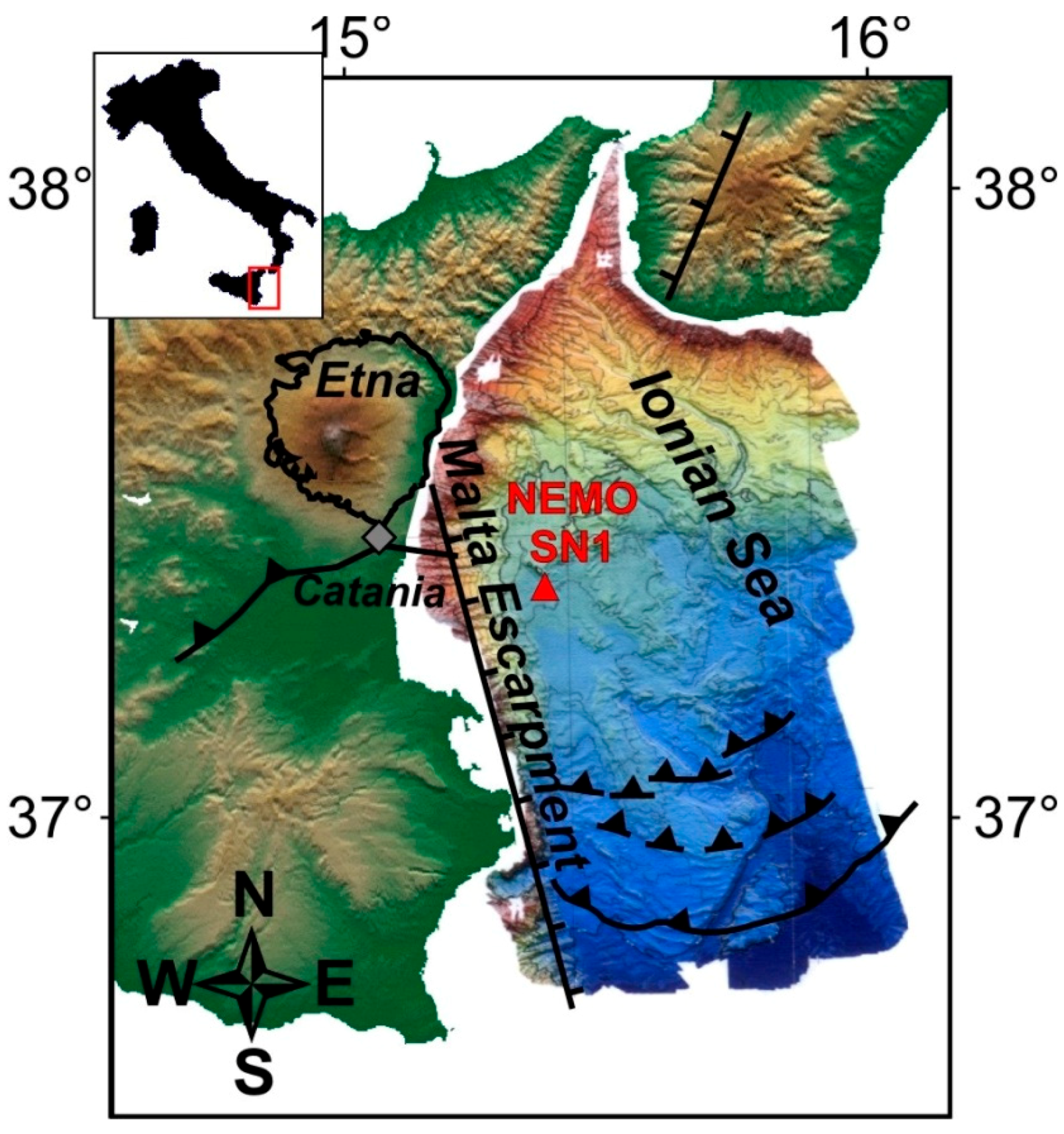
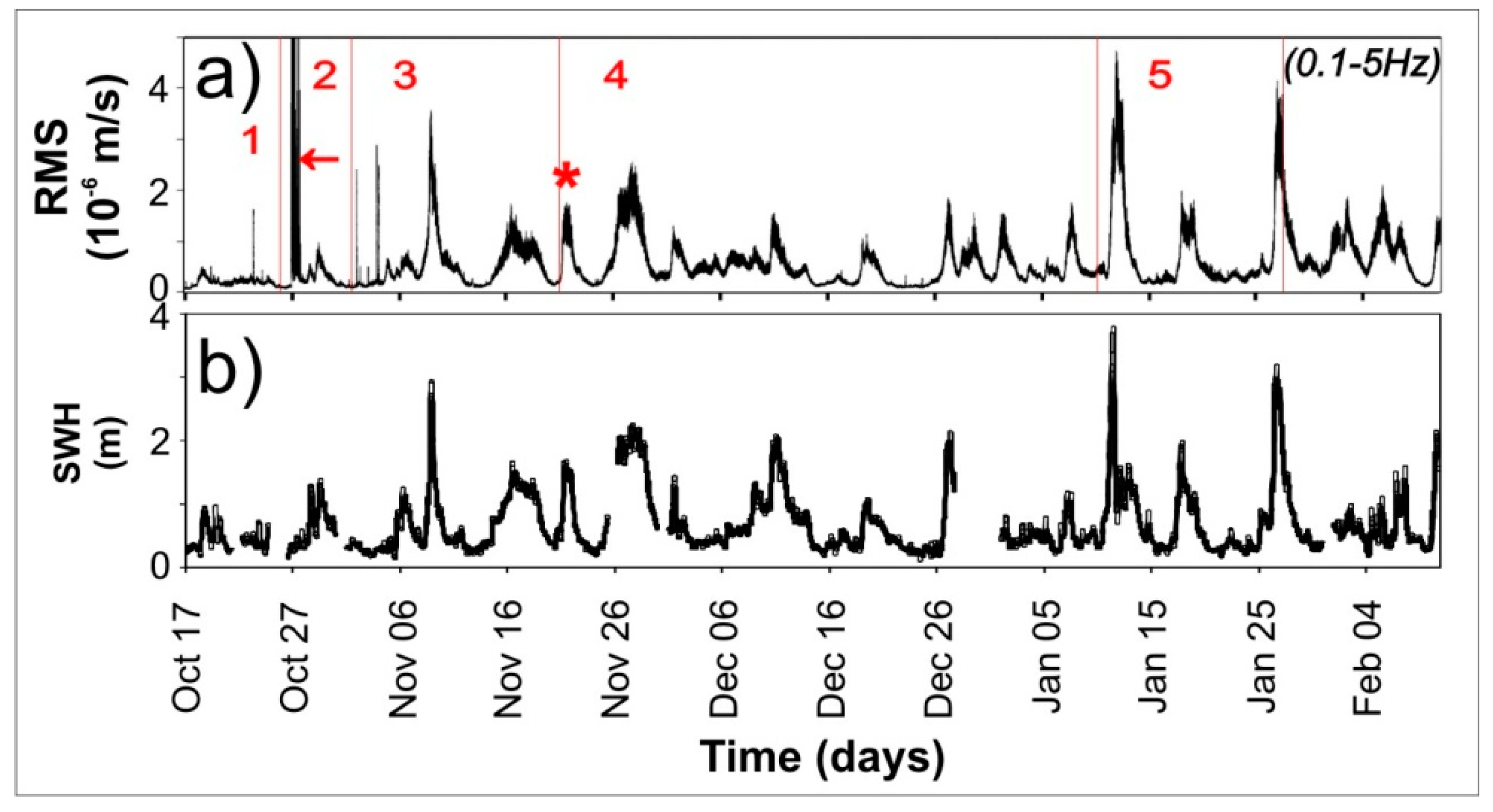
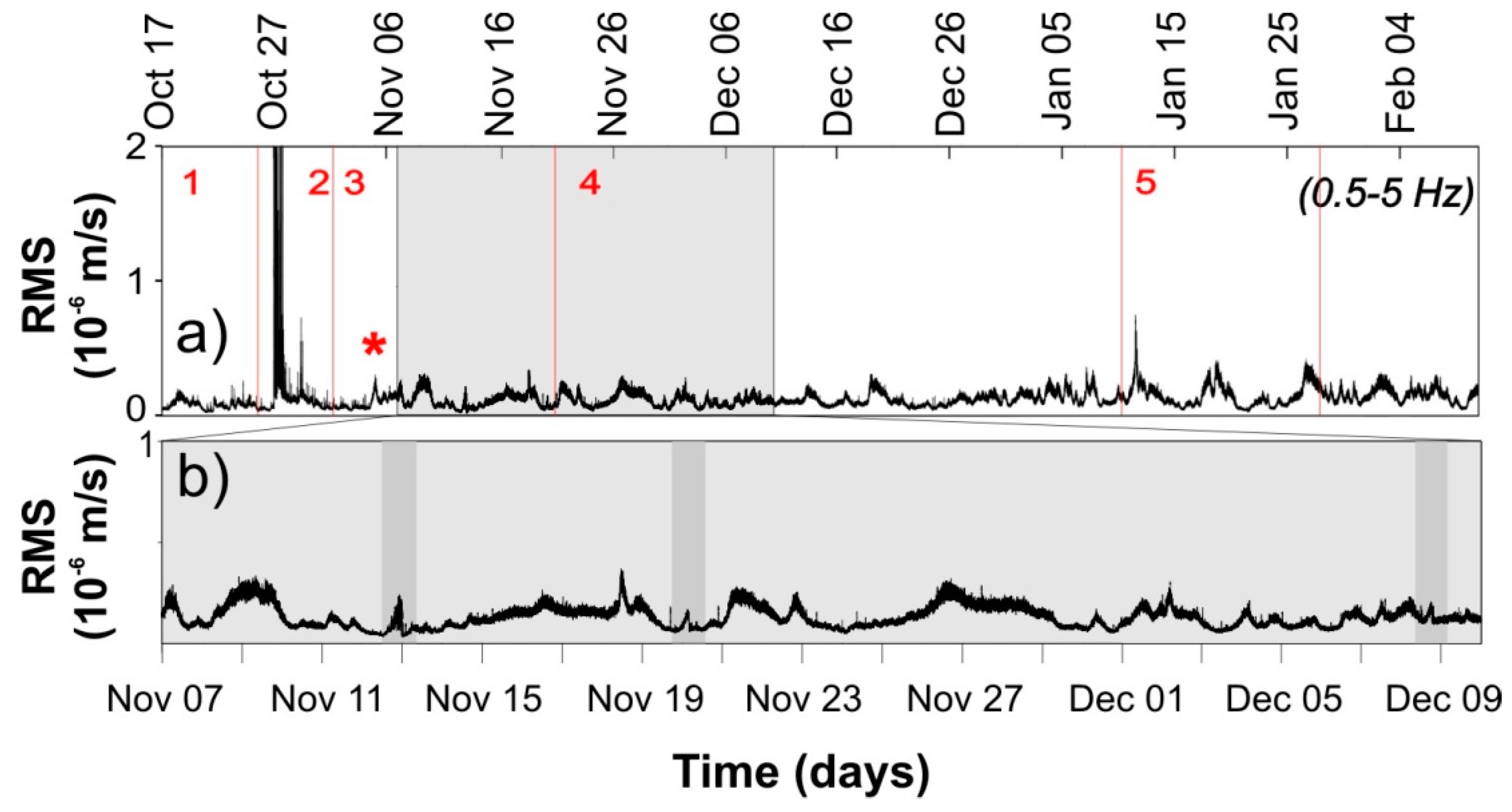
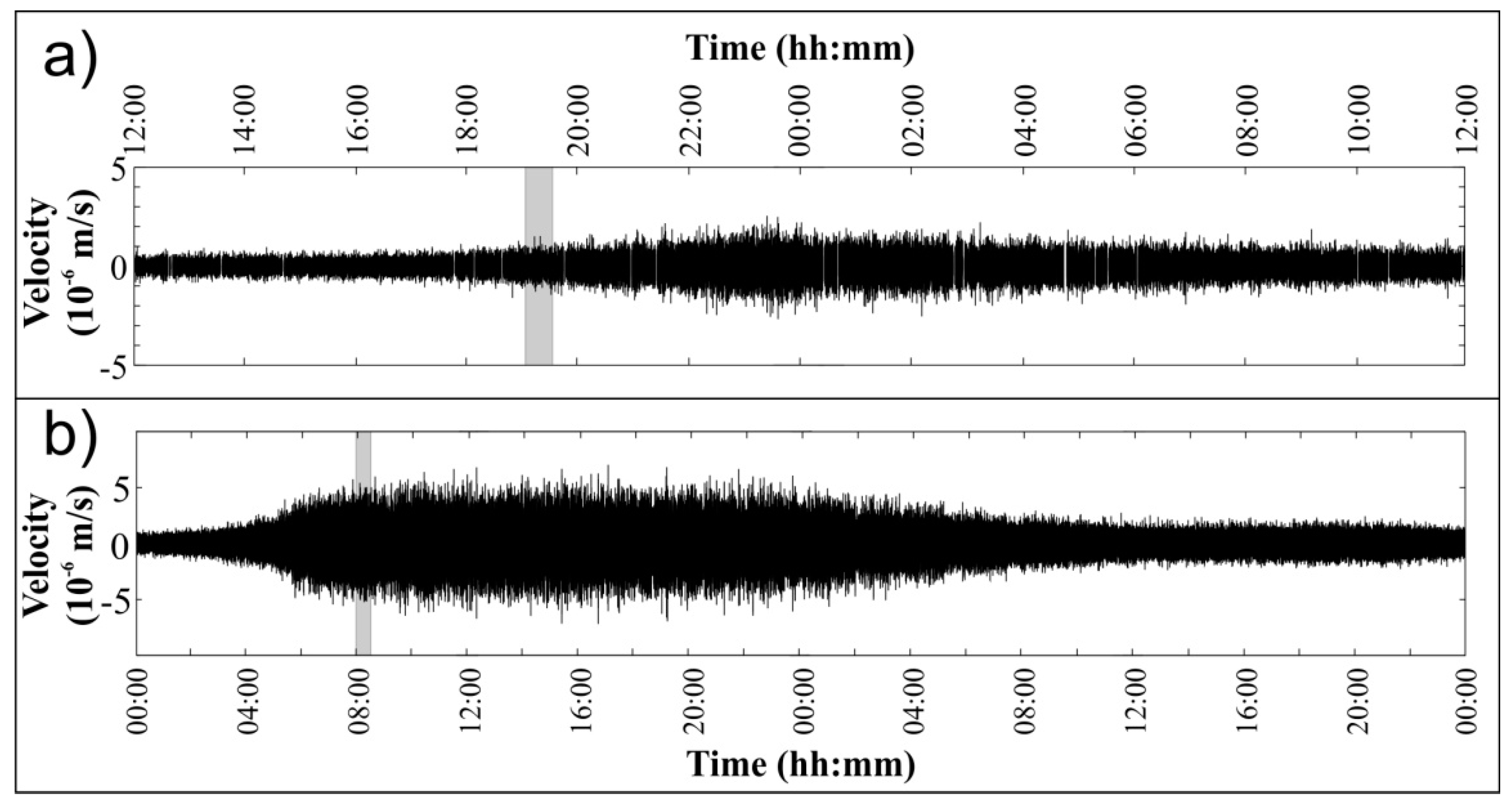
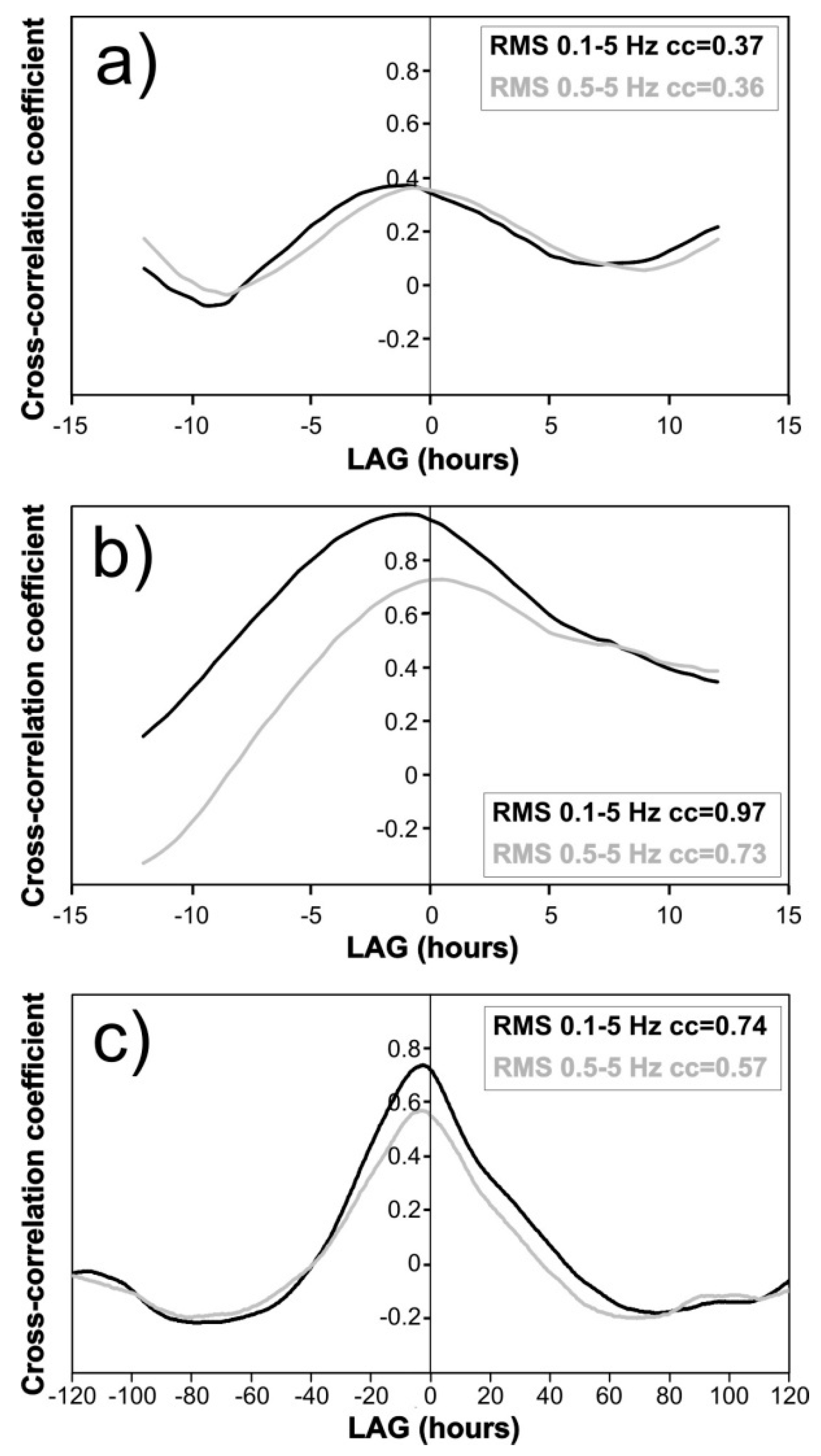
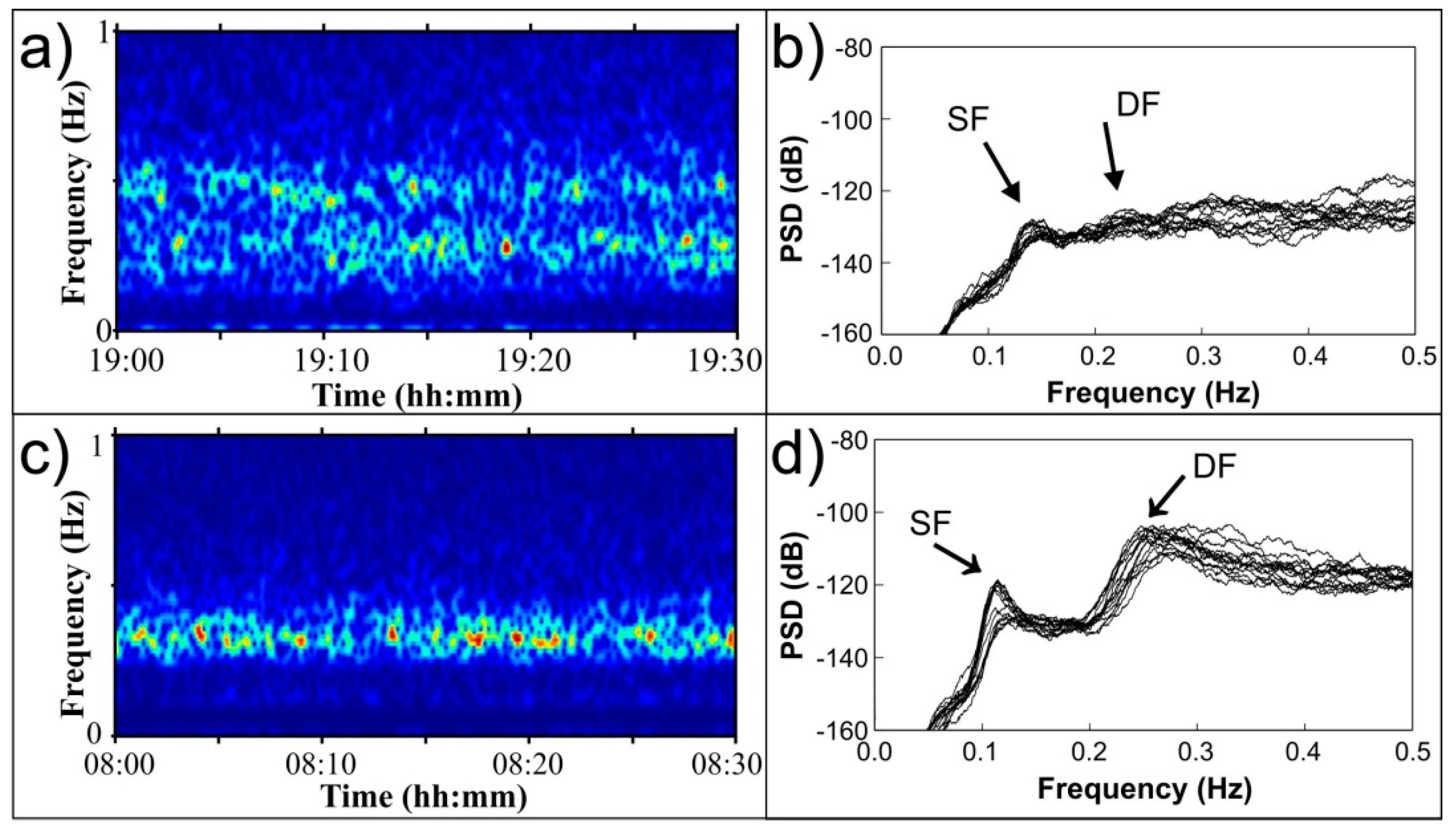
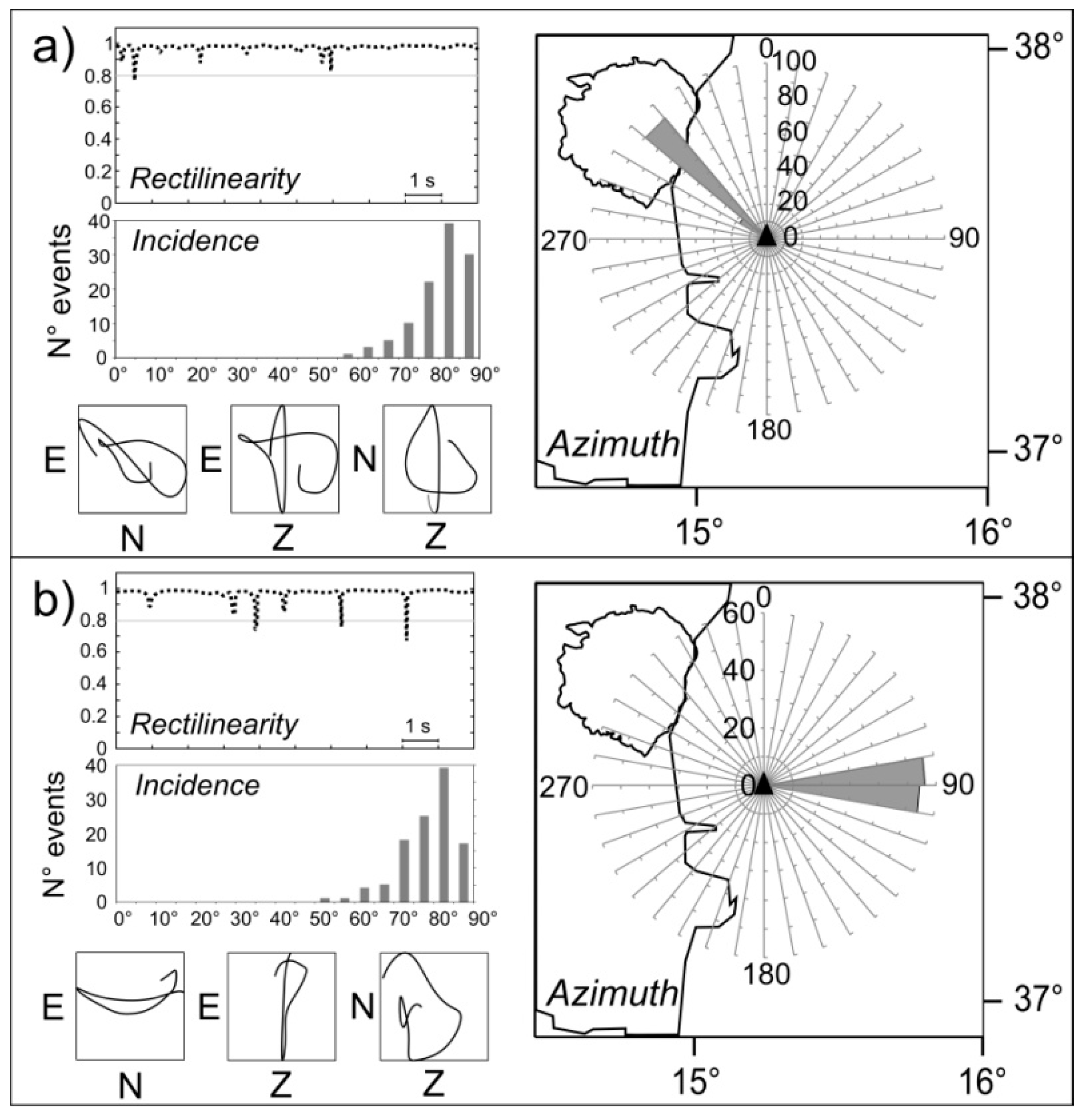
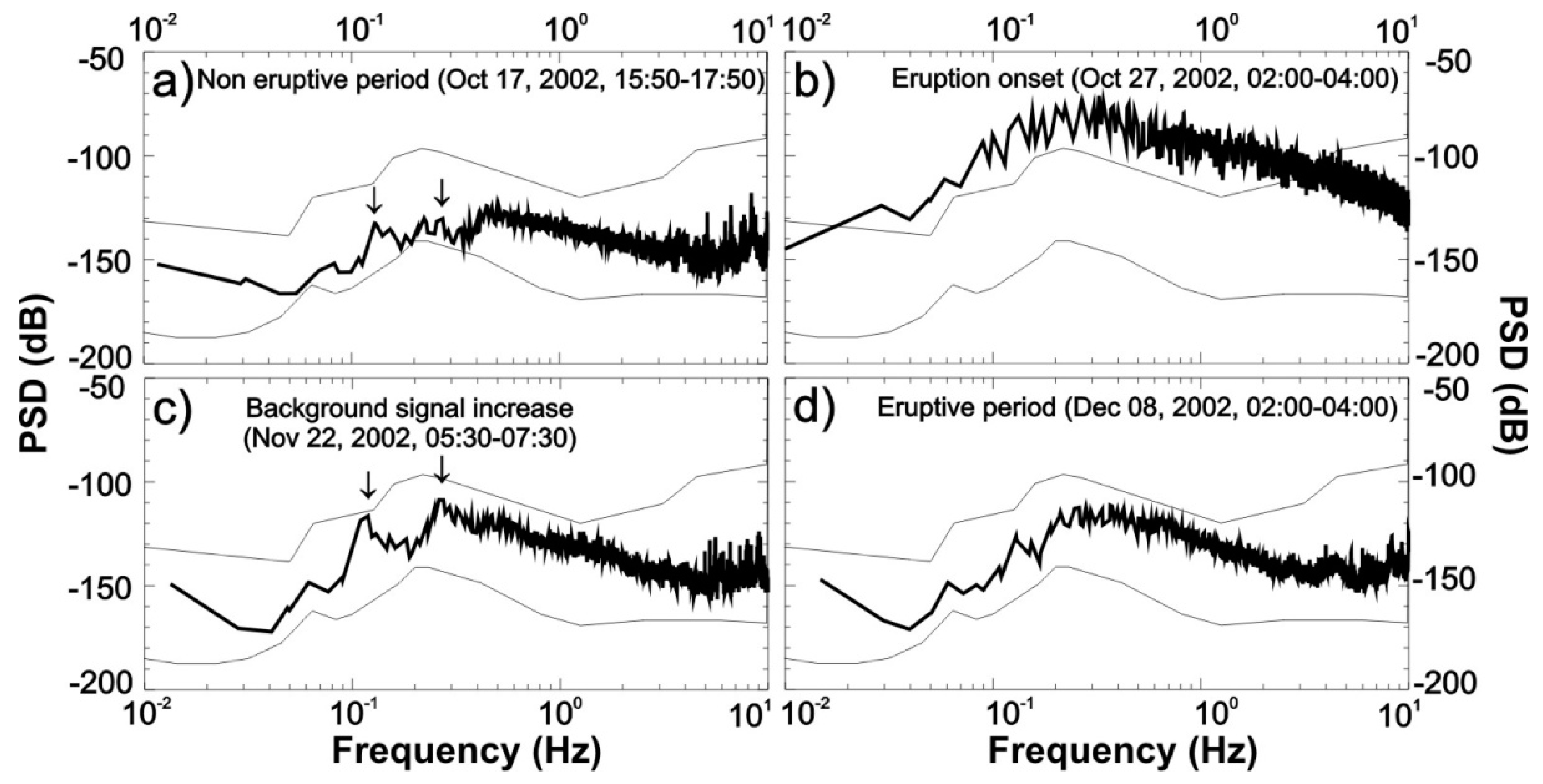
| Period | Date | Chronology of the Volcanic Activity | |
|---|---|---|---|
| 1 | pre-eruption | 15–25 October 2002 | Degassing activity occasionally accompanied by ash emissions |
| 2 | eruption onset | 26 October 2002 27 October 2002 28–30 October 2002 31 October 2002 | At 20:12 UTC an intense earthquake swarm marks the onset of the 2002-2003 Etna eruption Strong Strombolian activity on the north-eastern flank Intense fire fountain activity on the southern flank End of the effusive activity on the southern flank Persistence of the explosive activity |
| 3 | Eruption (explosive activity) | 1–11 November 2002 12–14 November 2002 15–21 November 2002 | Intense fire fountain activity on the southern flank Intermittent Strombolian activity Alternation of Strombolian activity and lava fountain episode |
| 4 | Eruption (explosive and effusive activity) | 22 November 2002 23–25 November 2002 26–27 November 2002 28–30 November 2002 1–10 December 2002 11–31 December 2002 | Effusive activity Middle-high explosive activity Fountaining activity Strong jets and ash emission of explosive vent Explosive activity on the southern flank Effusive and explosive activity with variable intensity on the south-eastern flank |
| 5 | end of eruption | 1–27 January 2003 28 January 2003 | Progressive decrease of the frequency and intensity of explosive activity End of eruptive activity |
© 2019 by the authors. Licensee MDPI, Basel, Switzerland. This article is an open access article distributed under the terms and conditions of the Creative Commons Attribution (CC BY) license (http://creativecommons.org/licenses/by/4.0/).
Share and Cite
Sgroi, T.; Di Grazia, G.; Favali, P. Volcanic Tremor of Mt. Etna (Italy) Recorded by NEMO-SN1 Seafloor Observatory: A New Perspective on Volcanic Eruptions Monitoring. Geosciences 2019, 9, 115. https://doi.org/10.3390/geosciences9030115
Sgroi T, Di Grazia G, Favali P. Volcanic Tremor of Mt. Etna (Italy) Recorded by NEMO-SN1 Seafloor Observatory: A New Perspective on Volcanic Eruptions Monitoring. Geosciences. 2019; 9(3):115. https://doi.org/10.3390/geosciences9030115
Chicago/Turabian StyleSgroi, Tiziana, Giuseppe Di Grazia, and Paolo Favali. 2019. "Volcanic Tremor of Mt. Etna (Italy) Recorded by NEMO-SN1 Seafloor Observatory: A New Perspective on Volcanic Eruptions Monitoring" Geosciences 9, no. 3: 115. https://doi.org/10.3390/geosciences9030115
APA StyleSgroi, T., Di Grazia, G., & Favali, P. (2019). Volcanic Tremor of Mt. Etna (Italy) Recorded by NEMO-SN1 Seafloor Observatory: A New Perspective on Volcanic Eruptions Monitoring. Geosciences, 9(3), 115. https://doi.org/10.3390/geosciences9030115






